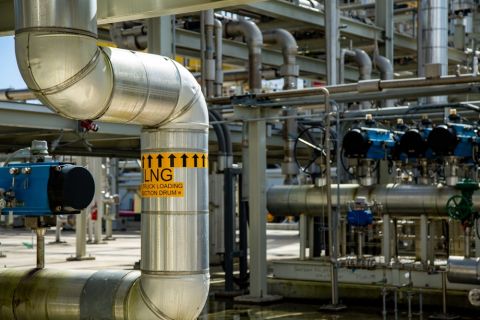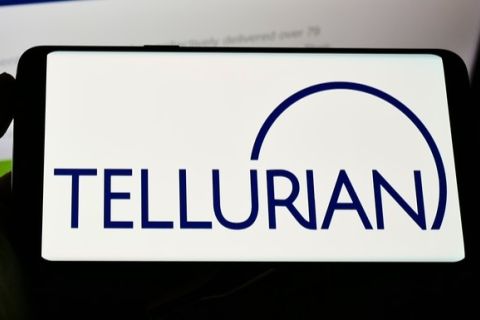Amid recent $30 oil and $5 gas, and the run-up in E&P share prices fueled by merger rumors, one would think it would be hard to land undervalued upstream stocks in today's market. Happily, that's not the case. The disconnect between high commodity prices and producer stock prices still lingers, and the chance to reel in some splashy Patch catches remains. The reason for this unusual market phenomenon may be that momentum investors still haven't fully embraced the growing certainty that sustainable high natural gas prices have arrived. Also, they may be a little jittery about all sectors of the stock market and the economy in general, despite the Fed's recent major interest-rate cuts. But as we move into the spring and summer of 2001, with working gas in storage already 40% below last year's levels, supply-demand fundamentals suggest a higher than usual plateau for Henry Hub prices and concurrently, more earnings and cash flow visibility for domestic producers. As that unfolds, heads on Wall Street will turn and investors will be casting about for the best growth and value stocks. But which upstream stocks to choose? To find out, Oil and Gas Investor recently visited with three top E&P analysts: Shannon L. Nome, managing director and senior energy analyst for Banc of America Securities LLC in Houston; Greg L. McMichael, senior vice president and small-cap E&P analyst for A.G. Edwards in Denver; and Bob Morris, director, U.S. equity research, E&P, for Salomon Smith Barney in New York. Eyeing average oil prices this year in the $24 to $27 range and gas prices of $5 to $5.25, they focus on valuation; growth in production, cash flow and net asset value; exploration exposure and leverage to high natural gas prices. Investor Shannon, your top large-cap pick? Nome Above $5 billion, the greatest opportunity lies in Devon Energy. It has grown by quantum leaps for the past two years, thanks to two company-transforming acquisitions- PennzEnergy and Santa Fe Snyder . Already active in the Powder River and San Juan Basin coalbed-methane plays, Devon's position in coalbed gas was bolstered by the Raton Basin properties it received from PennzEnergy. The Santa Fe Snyder purchase brought an enormous inventory of international drilling opportunities offshore West Africa, China, Brazil and Indonesia, as well as the Gulf of Mexico. The reason DVN has lagged recently is due to investor uncertainty about whether the company can reshape itself from a traditional acquire-and-exploit operator into an exploration-drilling growth vehicle, particularly internationally. We think it can and expect 2001 production to grow to 760.5 billion cubic feet equivalent of gas, from 725.8 Bcfe last year. Notably, Devon will be spending only $1.135 billion to do that while it generates $1.9 billion in cash flow. Thus, it will have $765 million of free cash flow to ramp up drilling further or do another acquisition. Morris Devon is going through a metamorphosis. Traditionally, it has grown through acquisitions. But its two recent major acquisitions allow it to grow reserves and production through the drillbit going forward. In fact, about one-third of Devon's $1.1-billion capital budget this year is earmarked for exploration. Look for 2001 production to grow 5%. Investor Greg, your top large-cap pick? McMichael Anadarko Petroleum is the premier company in our upstream oil and gas group. Recasting itself as a North American natural gas producer following the UPR merger, it has the deepest portfolio of exploration opportunities among its peers and a sizeable inventory of undeveloped acreage. Including its international holdings in Algeria, Latin America, the republic of Georgia, Australia and offshore West Africa, Anadarko's overall prospects have a net risked reserve potential of 3 billion barrels of oil equivalent; meanwhile, it has below-average drillbit finding costs of $5.50 per BOE and superior reserve replacement. Expect the company to grow annual per-share cash flow and production at double-digit rates through 2002. Morris Anadarko 's stellar track record of exploration success has resulted in a better-than-average production growth profile. This year, we're looking for 17% growth in output. Contributors will be its recent acquisition of Calgary's Berkley Petroleum , its Bossier play in East Texas, the Alpine Field in Alaska, two subsalt fields in the Gulf of Mexico and additional production from Algeria. Investor Greg, any other larger-cap picks? McMichael Apache Corp. Since January 2000, it has made more than $2.3 billion of accretive, low-cost acquisitions which have increased its size roughly 50%. Given this, Apache is poised for another year of 30% production growth, which should generate 2001 earnings and cash flow growth of 30% and 24%, respectively. Going forward, Apache still has a lot of dry powder to do more acquisitions. Also, it has started to expand its exploration focus. Its recent gas discovery, Ladyfern, in northeast British Columbia may have gross reserve potential exceeding 500 Bcfe. Morris Apache is a story of excellent production growth, but growth resulting mainly from recent acquisitions. For 2001, we also see output increasing 30%, with drillbit activity accounting for 5% to 10% of that gain. Internationally, the company has a very active drilling program in Egypt and Australia. Going forward, Apache has an inside track, in terms of its ability to make acquisitions from the majors, and should continue to pick off spin-offs from them. It is particularly good at adding value to assets bought by reducing costs and increasing production. Investor Bob, any other large-cap picks? Morris EOG Resources . It was the third-best performer in the S&P 500 last year, benefiting from higher gas prices. In 2000, this 75% gas-leveraged company grew unhedged volumes in the Rockies, Midcontinent and Gulf Coast regions 8%; we see those volumes growing another 4% to 5% this year. Similar to Devon, EOG is ramping up its exploration efforts. In fact, about 25% of its budget this year will target exploration opportunities, primarily onshore North America. We also like Cross Timber s, a solid North American gas story, focused mainly in East Texas and the Arkoma and Permian basins. Gas volumes should grow 20%, this year and next. Impressively, it will achieve this growth by spending only half this year's $500 million of cash flow; thus it will have plenty of excess cash flow available to pay down debt and/or pursue acquisitions. Investor Shannon, your midcap picks? Nome Newfield Exploration , historically focused on the Gulf of Mexico's shelf, has during the past few years expanded into the onshore Gulf Coast, China's Bohai Bay and Australia. As with Devon, there is some lingering investor uncertainty as to whether Newfield can make its recent expansion work. For that reason, the stock has underperformed its peers during the past year. But by almost any measure, the 75% gas-weighted company is now very attractively valued, especially given the outlook for gas prices. Also, one must remember: this is a company that has consistently underpromised and overdelivered. This year, Newfield should book reserve additions in Bohai Bay and have a full year's contribution from Lariat Petroleum, the Tulsa producer it acquired earlier this year. We see 20% to 25% production growth in 2001. We also like 90% gas-weighted Louis Dreyfus Natural Gas . It has a treasure trove of low-risk gas drilling opportunities in the Sonora Field in the Permian Basin and higher-reward exploration prospects in the South Texas Wilcox gas play. For 2001, we see 17% production growth. Currently, 56% of the company's gas production is hedged at a weighted average price north of $5 per thousand cubic feet, so it's locking in good value and returns for investors. We also like Ocean Energy . Investors aren't paying much on a reserve-per-share basis for the stock, but they're getting the gravy of the company's exploration upside. For example, Ocean is drilling a well offshore Equatorial Guinea, Oreja Marina, in which it has 37% fully carried working interest, and another prospect offshore Angola. Both have billion-barrel oil-reserve potential. In the Gulf of Mexico, the company, which has been financially re-engineered, is bringing online its 200- to 300-Bcf Hickory gas prospect. And when its Nansen and Boomvang prospects-offering combined reserve potential of 75- to 100 million barrels of oil-come online in late 2001/early 2002, they could double the company's Gulf production. With the contribution from its recent Texoil acquisition, Ocean's output this year should grow 9%. Investor Greg, any midcap favorite? McMichael Vintage Petroleum . It has the best rate-of-return economics in our midcap coverage group. When this company invests $1 in acquisitions or exploration, in four years it gets back $4. It has very low all-sources finding, development and acquiring costs-roughly $3 per BOE, which is about half the industry average. The 70% oil-leveraged company has sustainable internal production and cash flow growth in the double digits from its core holdings in the U.S. and Argentina. It also has meaningful exploration upside, domestically and in Yemen. In addition, having cleaned up its balance sheet, it has the capacity to do $500 million worth of acquisitions. The stock currently trades at about half our year-end 2000 estimated net asset value of $41 per share. Morris Vintage historically has been able to increase production on acquired properties more than 50%, and has a solid drilling inventory domestically and internationally. During the next three to five years, it should be able to grow its low-risk, exploitation-type production in Argentina at double-digit rates annually. And with its acquisition last year of Calgary producer Cometra Energy , it should grow both through the drillbit and acquisitions in Canada. Investor Bob, any other midcap picks? Morris Stone Energy is the premier producer in the shallow-water Gulf of Mexico and the market hasn't fully appreciated yet its merger with Basin Exploration . Historically, 75% gas-focused Stone has grown through the acquisition of mature Gulf of Mexico properties that weren't fully exploited. Basin, on the other hand, focused more on rank wildcat prospects. Now, Stone is in a position to grow by pursuing both avenues, with Basin providing a good inventory of undeveloped offshore acreage and prospects. This year, we're looking for 15% production growth. Chesapeake Energy , 90% gas-weighted, is a classic turnaround story. It has transformed itself from a high-risk explorer focused on short-lived gas reserves in the Austin Chalk of Texas and Louisiana into a low-risk, acquire-and-exploit company focused in the Midcontinent-where it is the third-largest producer of long-lived gas reserves behind BP and Apache. Given our long-term bullish outlook for natural gas prices, the stock is one of the better ways to play that investment thesis. This year, we're looking for 30% production growth. Investor Greg, your favorites among smaller-cap producers? McMichael Evergreen Resources has the highest annual cash flow growth rate-35% over 2000-02-of any of our small-cap companies. On the production side, we see gas output growing 57% in 2001 and 15% next year. The driver of all this growth is Evergreen's coalbed-methane drilling in the Raton Basin in southern Colorado. The wells are highly economic, with finding costs in the range of 25 to 30 cents per Mcf. Notably, since only 20% of the company's cash flow is needed to replace production, it's throwing off 80% free cash flow for growth. As noted in our April 1999 study of free cash flow, that's unusually high. We expect Evergreen to double its Raton reserves and production during the next three to four years. Meanwhile, it has an onshore U.K. coalbed-methane drilling program that could add $20 to $25 per share to net asset value during the next few years. We also like Swift Energy . While all its production and most of its reserves are onshore the Gulf Coast, the investment thesis here is mainly onshore exploration in New Zealand's Taranaki Basin. There, Swift has made two significant early-stage discoveries and booked 20 million barrels of oil reserves. Over time, New Zealand has the potential to double or triple the company's net asset value, now about $35.50 per share. This year and next, look for Swift to grow production 20% and 25%, respectively. We also like Remington Oil and Gas . Its new management since 1998 has grown proved reserves at a compound annual rate of 34% through exploration onshore Texas and Mississippi and on the Gulf of Mexico shelf. At the same time, it has reduced operating costs 50% and trimmed debt-total capitalization from north of 40% to around 27%. Last year, it replaced 380% of its production at a finding cost of about 97 cents per Mcfe versus $1.50 for most other Gulf of Mexico producers. While 2000 output grew 20%, we're looking for production this year to climb another 30%, as cash flow grows at an annual rate of 25% through 2002. Importantly, Remington's total drillbit exposure this year is 335 Bcfe-more than double its year-end 2000 proved reserves. Investor Shannon, your favorite among smaller-caps? Nome Spinnaker Exploration , which has a huge 3-D seismic database that virtually covers the entire Gulf of Mexico. While its stock isn't necessarily cheap, this 96% gas-leveraged producer far and away has the characteristics that could make it a core growth holding in any portfolio. For 2001, we're modeling a 60% increase in production, to 48.4 Bcfe, on top of a 131% jump in output in 2000. Simply put, every time Spinnaker puts a drillbit in the ground in the Shelf and deepwater Gulf, it has the potential for a find that could transform the company. Its recent Frontrunner deepwater discovery-with reserve potential of 100 million BOE-is a good example.
Recommended Reading
Battalion in Compliance with NYSE American after 2023 Meeting
2024-02-13 - Previously, Battalion Oil was not in compliance with the NYSE after failing to hold an annual meeting of stockholders during the fiscal year ending Dec. 31.
JMR Services, A-Plus P&A to Merge Companies
2024-03-05 - The combined organization will operate under JMR Services and aims to become the largest pure-play plug and abandonment company in the nation.
New Fortress Energy Sells Two Power Plants to Puerto Rico
2024-03-18 - New Fortress Energy sold two power plants to the Puerto Rico Electric Power Authority to provide cleaner and lower cost energy to the island.
Tellurian Executive Chairman ‘Encouraged’ by Progress
2024-03-18 - Tellurian announced new personnel assignments as the company continues to recover from a turbulent 2023.
Kissler: OPEC+ Likely to Buoy Crude Prices—At Least Somewhat
2024-03-18 - By keeping its voluntary production cuts, OPEC+ is sending a clear signal that oil prices need to be sustainable for both producers and consumers.





